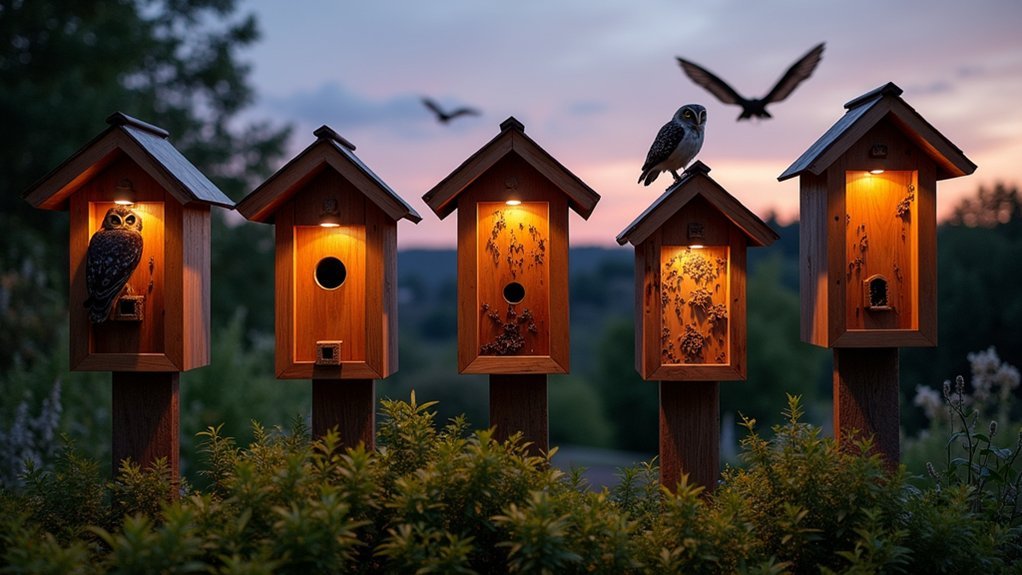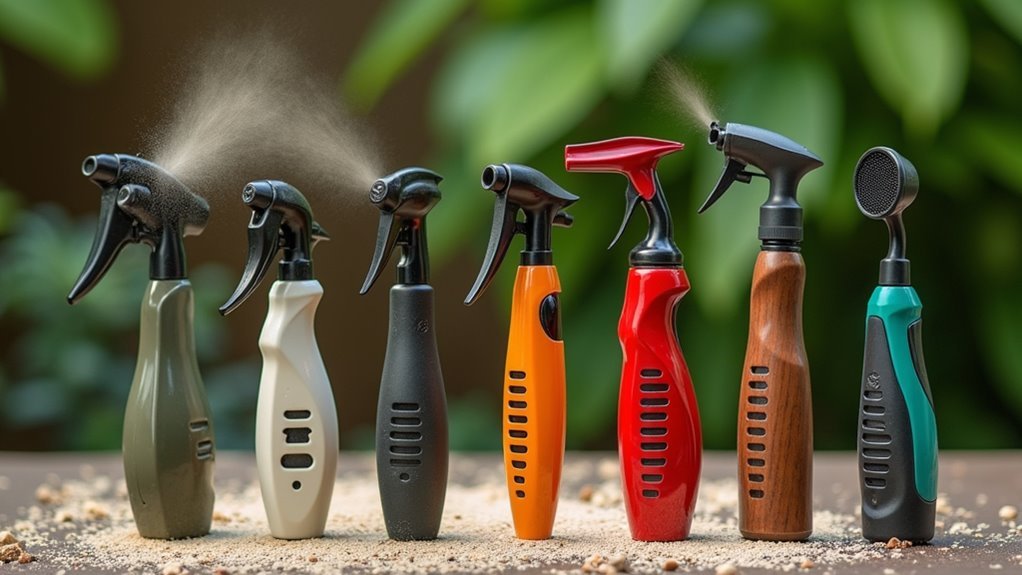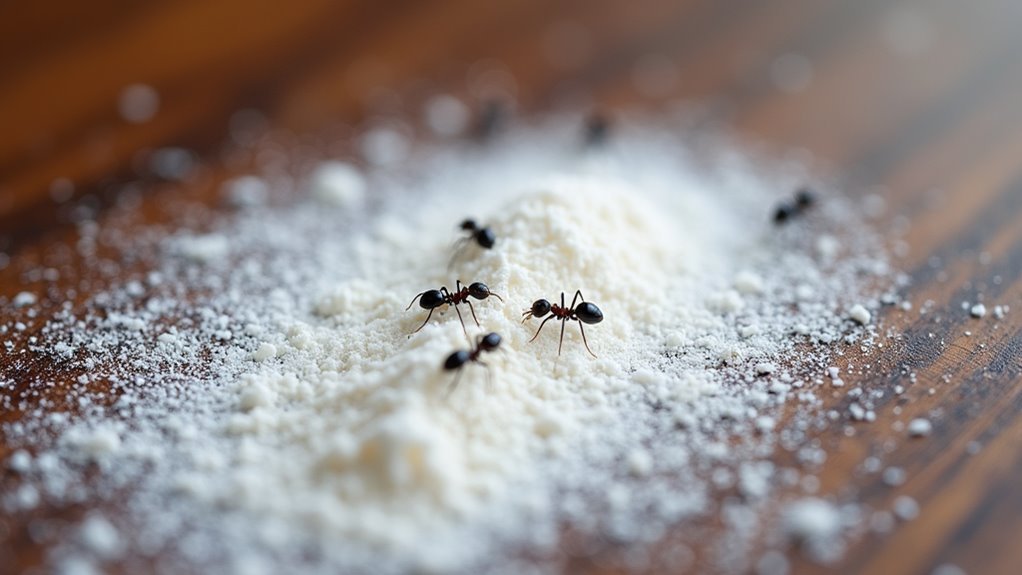Are you tired of battling garden pests with chemicals that harm the environment? Natural predators like owls and bats can become your allies in pest management, consuming thousands of insects nightly. You’ll find that installing the right habitat attracts these beneficial creatures to your property, creating a sustainable ecosystem that works round the clock. The right owl or bat house makes all the difference between occasional visitors and established colonies that provide consistent pest control. Let’s explore your best options.
Hausse Fake Owl Decoy Bird Scarecrow for Garden Protection
Gardeners battling persistent pest birds will find the Hausse Fake Owl Decoy an effective first line of defense. This realistic 13.6-inch scarecrow features intimidating eyes and detailed feathers that fool unwanted visitors into believing a predator has claimed your space.
You’ll appreciate the versatility—it works in gardens, patios, orchards, and even as indoor decor. For maximum effectiveness, fill the bottom tab with sand for stability or mount it on a pole. With a 4.2-star rating from over 900 customers, this eco-friendly pest management solution offers a humane alternative to chemicals. It’s particularly useful against squirrels and common garden birds, though results may vary with stubborn woodpeckers.
Best For: Homeowners and gardeners looking for a humane, cost-effective way to protect gardens, orchards, and outdoor spaces from birds, squirrels, and other small pest animals.
Pros:
- Realistic design with intimidating features (eagle beak, frightening eyes, detailed feathers) effectively deters most common garden birds and pests
- Versatile usage across multiple settings including gardens, patios, farmland, and even as decorative indoor items
- Environmentally friendly alternative to chemical pest control with sturdy construction that withstands outdoor conditions
Cons:
- Mixed effectiveness against certain persistent birds like woodpeckers and swallows according to customer reviews
- Requires proper setup with sand filling or mounting for stability to prevent tipping over
- May lose effectiveness over time as local birds become accustomed to its stationary presence
Glintoper Plastic Fake Owl Bird Scarecrow for Garden Bird Deterrent
While not a traditional owl house, the Glintoper Plastic Fake Owl Bird Scarecrow offers an effective pest control solution for homeowners seeking a non-lethal deterrent. Standing at 16.5 inches tall, this realistic-looking decoy features a spring-connected head that sways with the wind, mimicking natural movement.
You’ll appreciate its versatility—fill the bottom with sand for stability or mount it on a pole for elevated protection. Crafted from durable, weather-resistant plastic with non-fading paint, it’s built to last through all seasons. Beyond its practical pest-deterring capabilities against birds, squirrels, and raccoons, it doubles as an attractive decorative piece for your garden or patio.
Best For: Homeowners with garden spaces who need an eco-friendly, humane solution to deter birds, squirrels, raccoons, and other pests without harming them.
Pros:
- Features a spring-connected head that creates realistic swaying movement in the wind, enhancing its effectiveness as a deterrent
- Versatile installation options with a hollow bottom for pole mounting or sand filling for stability
- Weather-resistant construction with non-fading paint ensures long-lasting performance in outdoor conditions
Cons:
- At 16.5 inches tall, may be too large for small garden spaces or containers
- Some pests may become accustomed to the static presence over time if not occasionally repositioned
- Requires proper placement and sometimes additional deterrent methods for particularly persistent pest problems
Ultrasonic Bat Repellent Devices (2 Pack, Rechargeable)
Homeowners battling persistent bat problems will find the Ultrasonic Bat Repellent Devices an effective, humane solution that doesn’t require physical removal or harmful chemicals. These rechargeable units emit high-frequency sound waves that specifically target bats’ sensitive hearing, driving them away without harming them.
You’ll appreciate the versatility of these devices in attics, porches, garages, or any bat-prone areas. Simply charge via USB and place them strategically. For best results, use continuously for three weeks. The compact design requires no drilling or complex installation.
Many users report seeing results within days and notice fewer mice as an added benefit.
Best For: Homeowners seeking a humane, chemical-free solution to bat infestations in attics, porches, garages, or other indoor and outdoor spaces.
Pros:
- Eco-friendly and safe for humans and pets, utilizing silent ultrasonic waves rather than harmful chemicals or traps
- Rechargeable USB battery eliminates the need for constant battery replacement while ensuring continuous operation
- Simple setup with no drilling required—just charge and place in problem areas
Cons:
- Requires continuous use for approximately three weeks before optimal results may be observed
- Ultrasonic waves can be weakened by walls and dense objects, potentially requiring multiple units for large spaces
- Limited 30-day warranty period compared to similar pest control products
Owl House Cedar Prebuilt Barn & Screech Owl Nesting Box
The WildYard Cedar Owl House offers an excellent option for anyone seeking natural pest control without chemicals or traps. This ready-to-hang nesting box arrives fully assembled with included wood shavings and mounting hardware.
Crafted from durable cedar wood, the 6×6×7-inch house withstands outdoor elements while providing a cozy habitat for screech owls and other bird species. You’ll appreciate the large front door that makes seasonal cleaning simple.
Though some users mention it’s smaller than expected for larger owl species, the box receives high marks (4.6/5 stars) for quality construction and attractive design. It’s an investment in your garden’s ecosystem and natural pest management.
Best For: Outdoor enthusiasts who want a simple, ready-to-use solution for attracting screech owls and other small birds while supporting natural pest control in their yard or garden.
Pros:
- Arrives fully assembled with mounting hardware and wood shavings for immediate installation
- Constructed from weather-resistant cedar wood for durability in outdoor conditions
- Features a convenient large front door for easy seasonal cleaning and maintenance
Cons:
- Size may be too small for larger owl species, limiting what birds you can attract
- At 3.79 pounds, may require sturdy mounting to prevent issues in windy conditions
- Some users report mixed results in successfully attracting owls despite proper installation
Hausse Fake Owl Decoys to Scare Birds Away (2 Pack)
For gardeners battling unwanted feathered visitors, the Hausse Fake Owl Decoys offer a humane solution without harmful chemicals or traps. These realistic-looking predators stand 10.6 inches tall with detailed features that convince pests to stay away.
You’ll appreciate the wind-activated rotating head design that enhances effectiveness by simulating movement. Each decoy includes a bottom tab for adding sand, increasing stability during outdoor placement.
Whether you’re protecting gardens, patios, or orchards, these versatile decoys work year-round. While most users report success deterring squirrels and various pests, they’re occasionally less effective against certain birds like crows. For best results, reposition them regularly.
Best For: Homeowners and gardeners seeking a humane, chemical-free way to protect their outdoor spaces from birds, squirrels, and other small pests.
Pros:
- Realistic owl design with rotating head creates convincing predator presence to deter unwanted wildlife
- Versatile placement options for gardens, patios, porches, and farmland with bottom tab for sand filling to increase stability
- Durable molded plastic construction allows for year-round outdoor use in all weather conditions
Cons:
- May have limited effectiveness against certain birds like crows that can become accustomed to the decoys
- Requires occasional repositioning to maintain effectiveness as pests may grow familiar with stationary decoys
- Some users report issues with the wind-activated head movement mechanism functioning properly
Factors to Consider When Choosing the Most Effective Owl and Bat Houses That Establish Natural Pest Control Colonies
When choosing owl or bat houses to support natural pest control, you’ll need to take into account several essential factors that determine their effectiveness. Your selection should account for proper sizing (8-12 inches deep for owls, 2-inch chambers for bats), weather-resistant materials like cedar or marine-grade plywood, strategic mounting locations 12-20 feet high away from disturbances, and design features tailored to your target species’ habits. These factors directly impact whether beneficial predators will establish colonies on your property, greatly enhancing your natural pest management efforts.
Subheading Discussion Points
Why should homeowners carefully evaluate their options before installing wildlife habitats? Choosing the right owl or bat house directly impacts your success in establishing natural pest control on your property.
You’ll need to prioritize durable materials like cedar wood or weather-resistant plastics that withstand the elements. Match the house size to your target species—larger owls need roomier accommodations than smaller bats.
Don’t overlook essential features like proper ventilation and maintenance access. These creatures require houses with adequate airflow and cleaning capabilities to maintain healthy colonies.
Select quiet, sheltered locations away from regular human activity, as both owls and bats prefer undisturbed environments. Consider installing multiple houses in different spots across your property to maximize your chances of attracting these beneficial predators and establishing effective natural pest control.
Optimal Size Requirements
Selecting appropriately sized homes for your pest-controlling wildlife guarantees successful colonization and long-term residence. For owls, choose houses measuring 12-18 inches in width and depth, with heights of 18-24 inches to provide ample nesting space. The entrance hole should be 6-8 inches in diameter to accommodate larger species like screech and barn owls.
Bat houses require different dimensions—3-6 inches wide with 12-24 inches of height for interior space. These dimensions allow multiple bats to roost together while ensuring proper air circulation. Install narrow vertical entrance slots (1-1.5 inches wide) that protect bats from predators.
Don’t overlook insulation requirements. Owl houses need thick walls (minimum 1 inch) to maintain stable temperatures during weather extremes, while bat houses should provide appropriate thermal protection for their smaller occupants.
Material Durability Concerns
Beyond proper dimensions, the longevity of your owl and bat houses hinges greatly on material quality. Weather-resistant cedar wood offers excellent durability against outdoor elements, ensuring your pest control allies have a stable home for years to come.
Consider sturdy molded plastic alternatives that resist wear while maintaining realistic designs. Whichever material you choose, proper construction with sealed joints and weatherproof finishes is essential to prevent moisture damage that could compromise the structure.
Don’t overlook the importance of non-fading, waterproof paint on exterior surfaces. This maintains both visual appeal and structural integrity through changing seasons.
Remember that regular maintenance is vital—inspect for damage and clean periodically to preserve material durability. Your diligence will create a safe, lasting environment for these natural pest controllers.
Location Placement Strategy
Strategic placement of your owl and bat houses dramatically impacts their effectiveness as pest control solutions. Mount owl houses 10-15 feet high near open fields where prey is abundant, while bat houses should be installed 12-15 feet above ground in sunny locations facing south or southeast to provide essential warmth.
Both housing types require clear flight paths without obstructions like dense trees or buildings. Your wildlife helpers need unimpeded access to enter and exit their homes when hunting.
Maintain distance from high-traffic areas and noise sources that could deter these natural pest controllers from settling in. Including a water feature nearby—such as a small pond or birdbath—creates a complete ecosystem by attracting insects and small animals that serve as food sources for your bat and owl residents.
Species-Specific Design Features
When you’re choosing owl and bat houses for pest control, design features tailored to specific species determine whether your wildlife allies will take up residence. Eastern Screech Owls require boxes approximately 6 x 6 x 7 inches with appropriately sized entrance holes that prevent predator access while allowing the owls entry.
Cedar wood offers ideal insulation and durability for owl houses, protecting occupants during extreme weather. For bat houses, consider that Little Brown Bats need adequate roosting chambers and flat surfaces as they prefer to gather in colonies.
Don’t overlook ventilation holes in both house types—they’re essential for preventing overheating, especially in warmer regions. Adding wood shavings to owl boxes mimics natural nesting conditions, greatly increasing the likelihood of attracting resident owl families who’ll patrol your property for pests.
Protection From Predators
Predator-proofing your owl and bat houses remains essential for establishing thriving colonies that’ll effectively control pests around your property. Select houses constructed from durable, weather-resistant cedar wood that naturally deters predators while withstanding environmental challenges.
Look for designs featuring appropriately sized entrance holes—large enough for your target species but too small for potential threats. Front-opening doors aren’t just convenient for you; they enable regular cleaning to prevent infestations that might attract predators.
Strategic placement considerably impacts predator protection. Mount houses at elevated heights where ground predators can’t reach them, and choose locations away from branches that could provide access routes. Consider houses with camouflaged exteriors that blend with their surroundings, making them less visible to threats while providing your beneficial pest controllers with a secure home base.
Proper Ventilation Systems
Beyond securing your owl and bat houses from predators, the ventilation system within these structures profoundly impacts their effectiveness as pest control solutions. When designing these habitats, you’ll need strategically placed vents that create cross-ventilation without exposing inhabitants to harsh elements.
Proper airflow serves multiple critical functions: it regulates internal temperature during hot weather, prevents moisture accumulation that leads to mold, and reduces odor from waste buildup. All these factors make the house more appealing to potential occupants.
Remember that ventilation requires balance—too many openings compromise protection from weather and predators, while insufficient airflow creates unhealthy living conditions. Your goal is creating a comfortable environment that encourages long-term colony establishment, which directly correlates to more effective pest control around your property.
Mounting Height Considerations
The ideal positioning of your owl and bat houses dramatically affects their success as natural pest control tools. Mount these houses 10 to 15 feet above ground to protect occupants from predators while guaranteeing they can easily spot prey.
For owl houses, select locations near open fields or water sources where rodents are abundant. Bat houses work best when placed near natural roosting sites and along established flight paths. Both species require sunny spots to maintain proper body temperature, so avoid shaded areas that discourage habitation.
Secure mounting is vital—any swaying or instability will deter wildlife from settling in. Also consider how you’ll access the houses for seasonal maintenance and cleaning, which guarantees long-term occupancy. Well-positioned houses not only attract wildlife but sustain their presence, creating effective natural pest management systems.
Frequently Asked Questions
How Long Does It Take for Owls to Inhabit a Nesting Box?
Owls may take several weeks to months to inhabit your nesting box. You’ll need patience as they scout locations. Placing the box before breeding season and in suitable habitat will improve your chances of success.
Can Multiple Bat Species Coexist in One House Design?
Yes, you’ll find multiple bat species can coexist in one house design if it provides varied chamber sizes and roosting spaces. Different species often have overlapping habitat needs but may use different sections of the house.
What Maintenance Do Owl and Bat Houses Require Yearly?
You’ll need to check your bat and owl houses annually for damage, clean them after nesting season, remove any pest infestations, and guarantee openings remain unobstructed. Don’t disturb during breeding periods.
How Far From Homes Should Bat Houses Be Installed?
You’ll want to place bat houses at least 20-30 feet from your home. They shouldn’t be too close to disturb you or too far to be effective. Avoid installing them directly above windows or doorways.
Do Owls Become Territorial Toward Humans Near Nesting Boxes?
Owls aren’t typically territorial toward humans near nesting boxes. You’ll rarely face aggression unless you’re directly threatening their young. They may observe you cautiously but generally maintain their distance while accepting your presence.





Leave a Reply